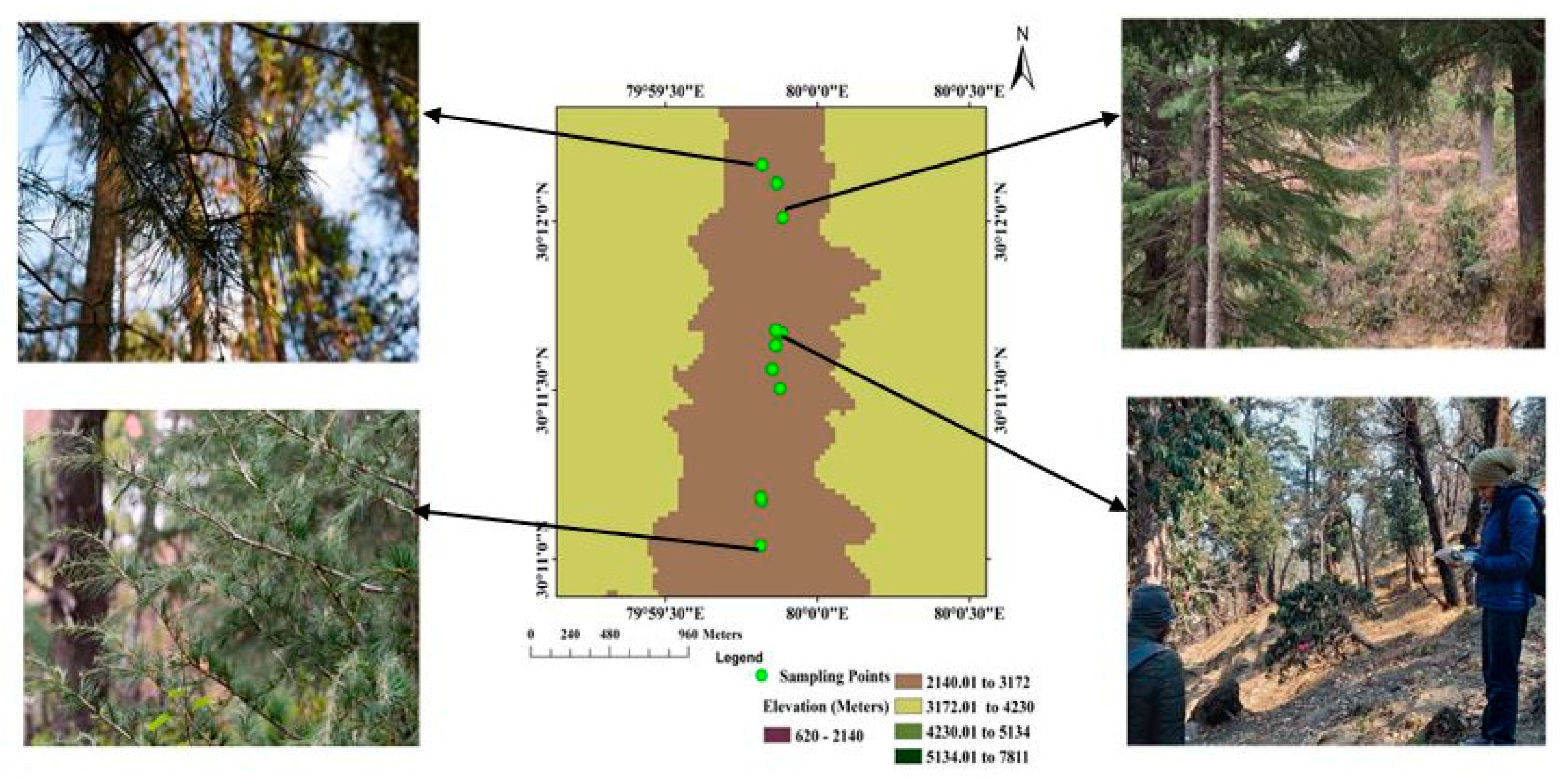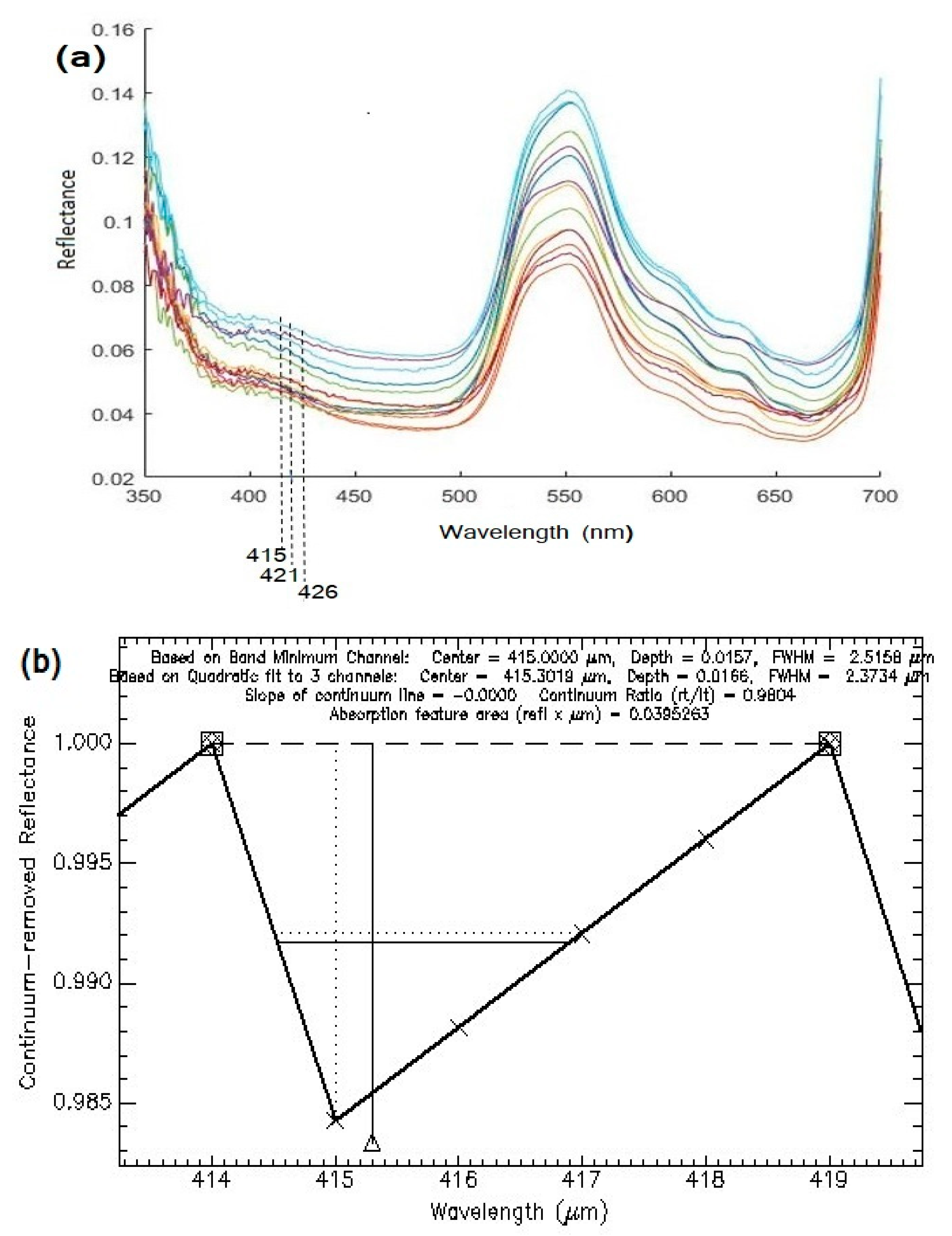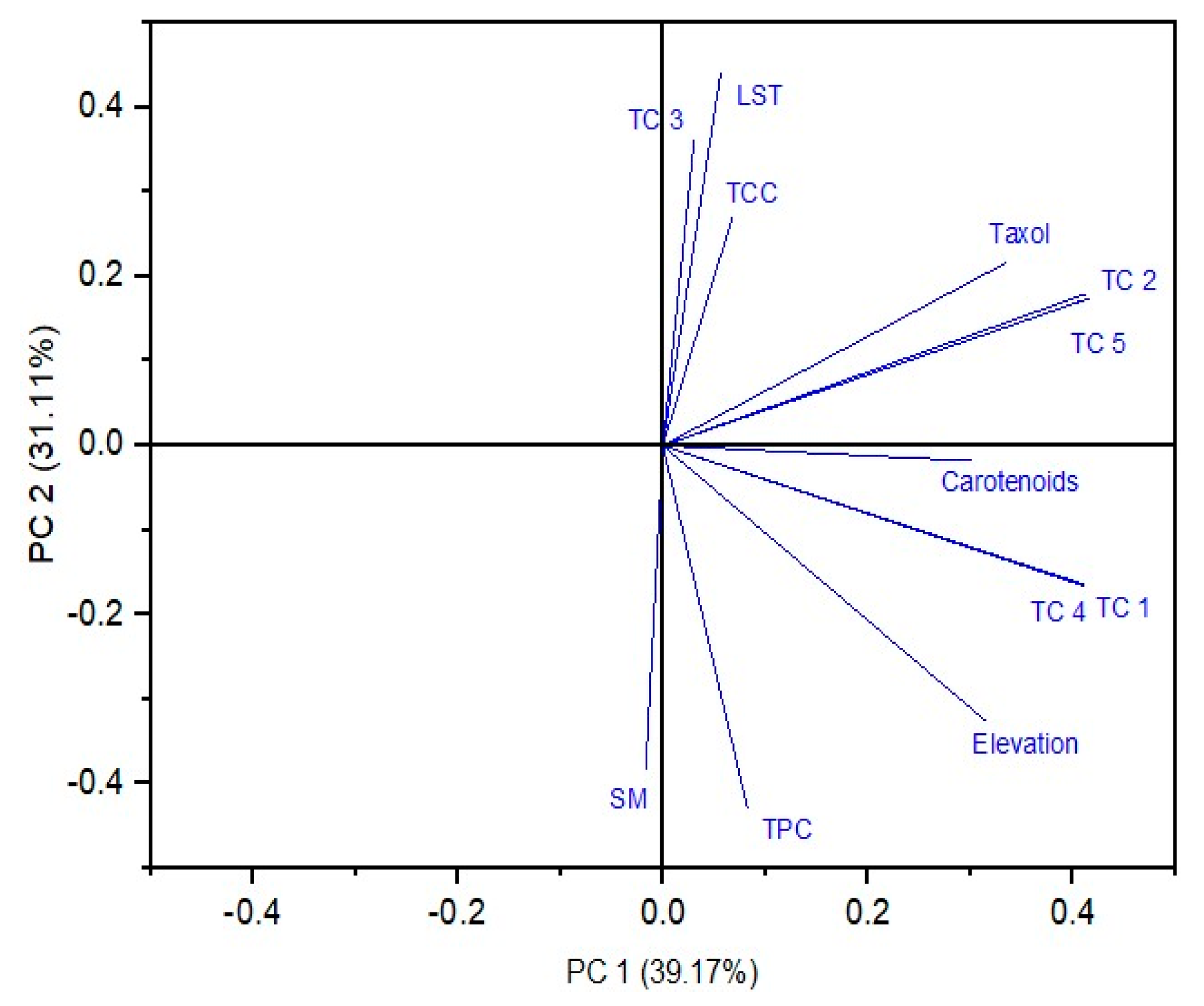Statistical Unfolding Approach to Understand Influencing Factors for Taxol Content Variation in High Altitude Himalayan Region
Abstract
:1. Introduction
2. Materials and Methodology
2.1. Study Area
2.2. Sample and Radiometer Data Collection
2.3. Robustness of Indices
2.3.1. Reflectance Based Indices
2.3.2. Absorption Based Indices
2.4. Soil Moisture and LST
2.5. Determination of Chlorophyll (TCC), Total Phenolic Content (TPC), and Taxol Content (TC)
3. Results and Discussion
3.1. Comparative Analysis between Indices, Selected Wavelengths, and Measured Taxol Content
3.2. Descriptive Statistics
3.3. Multivariate Analysis
3.4. Seriation Analysis
4. Conclusions
Author Contributions
Funding
Institutional Review Board Statement
Informed Consent Statement
Data Availability Statement
Acknowledgments
Conflicts of Interest
References
- Kokaly, R.F.; Skidmore, A.K. Plant phenolics and absorption features in vegetation reflectance spectra near 1.66 μm. Int. J. Appl. Earth Obs. Geoinf. 2015, 43, 55–83. [Google Scholar] [CrossRef] [Green Version]
- Lu, B.; He, Y.; Liu, H.H. Mapping vegetation biophysical and biochemical properties using unmanned aerial vehicles-acquired imagery. Int. J. Remote Sens. 2018, 39, 5265–5287. [Google Scholar] [CrossRef]
- Peng, Y.; Zhang, M.; Xu, Z.; Yang, T.; Su, Y.; Zhou, T.; Wang, H.; Wang, Y.; Lin, Y. Estimation of leaf nutrition status in degraded vegetation based on field survey and hyperspectral data. Sci. Rep. 2020, 10, 1–12. [Google Scholar] [CrossRef] [PubMed] [Green Version]
- Fine, P.V.; Salazar, D.; Martin, R.E.; Metz, M.R.; Misiewicz, T.M.; Asner, G.P. Exploring the links between secondary metabolites and leaf spectral reflectance in a diverse genus of Amazonian trees. Ecosphere 2021, 12, e03362. [Google Scholar] [CrossRef]
- Hui, C. Carrying capacity, population equilibrium, and environment’s maximal load. Ecol. Model. 2006, 192, 317–320. [Google Scholar] [CrossRef]
- Asner, G.P.; Martin, R.E. Conservation. Spectranomics: Emerging science and conservation opportunities at the interface of biodiversity and remote sensing. Glob. Ecol. 2016, 8, 212–219. [Google Scholar] [CrossRef] [Green Version]
- Jugran, A.K.; Bahukhandi, A.; Dhyani, P.; Bhatt, I.D.; Rawal, R.S.; Nandi, S.K. Impact of altitudes and habitats on valerenic acid, total phenolics, flavonoids, tannins, and antioxidant activity of Valeriana jatamansi. Appl. Biochem. 2016, 179, 911–926. [Google Scholar] [CrossRef]
- Díaz, S.; Kattge, J.; Cornelissen, J.H.; Wright, I.J.; Lavorel, S.; Dray, S.; Reu, B.; Kleyer, M.; Wirth, C.; Prentice, I.C. The global spectrum of plant form and function. Nature 2016, 529, 167–171. [Google Scholar] [CrossRef] [PubMed]
- Nisar, M.; Khan, I.; Simjee, S.U.; Gilani, A.H.; Perveen, H. Anticonvulsant, analgesic and antipyretic activities of Taxus wallichiana Zucc. J. Ethnopharmacol. 2008, 116, 490–494. [Google Scholar] [CrossRef] [PubMed]
- Shi, Q.W.; Kiyota, H. New natural taxane diterpenoids from Taxus species since 1999. Chem. Biodivers. 2005, 2, 1597–1623. [Google Scholar] [CrossRef] [PubMed]
- Kumari, N.; Srivastava, A.; Dumka, U.C. A long-term spatiotemporal analysis of vegetation greenness over the Himalayan Region using Google Earth Engine. Climate 2021, 9, 109. [Google Scholar] [CrossRef]
- Lin, D.; Xiao, M.; Zhao, J.; Li, Z.; Xing, B.; Li, X.; Kong, M.; Li, L.; Zhang, Q.; Liu, Y. An overview of plant phenolic compounds and their importance in human nutrition and management of type 2 diabetes. Molecules 2016, 21, 1374. [Google Scholar] [CrossRef]
- Hill, J.; Buddenbaum, H.; Townsend, P.A. Imaging spectroscopy of forest ecosystems: Perspectives for the use of space-borne hyperspectral earth observation systems. Surv. Geophys. 2019, 40, 553–588. [Google Scholar] [CrossRef]
- Shang, X.; Chisholm, L.A. Classification of Australian native forest species using hyperspectral remote sensing and machine-learning classification algorithms. IEEE J. Sel. Top. Appl. Earth Obs. Remote Sens. 2013, 7, 2481–2489. [Google Scholar] [CrossRef]
- Anand, A.; Pandey, M.K.; Srivastava, P.K.; Gupta, A.; Khan, M.L. Integrating Multi-Sensors Data for Species Distribution Mapping Using Deep Learning and Envelope Models. Remote Sens. 2021, 13, 3284. [Google Scholar] [CrossRef]
- Zarco-Tejada, P.J.; Morales, A.; Testi, L.; Villalobos, F. Spatio-temporal patterns of chlorophyll fluorescence and physiological and structural indices acquired from hyperspectral imagery as compared with carbon fluxes measured with eddy covariance. Remote Sens. Environ. 2013, 133, 102–115. [Google Scholar] [CrossRef]
- Li, F.; Miao, Y.; Feng, G.; Yuan, F.; Yue, S.; Gao, X.; Liu, Y.; Liu, B.; Ustin, S.L.; Chen, X. Improving estimation of summer maize nitrogen status with red edge-based spectral vegetation indices. Field Crop. Res. 2014, 157, 111–123. [Google Scholar] [CrossRef]
- Wu, C.; Niu, Z.; Tang, Q.; Huang, W. Estimating chlorophyll content from hyperspectral vegetation indices: Modeling and validation. Agric. For. Meteorol. 2008, 148, 1230–1241. [Google Scholar] [CrossRef]
- Singh, P.; Srivastava, P.K.; Malhi, R.K.M.; Chaudhary, S.K.; Verrelst, J.; Bhattacharya, B.K.; Raghubanshi, A.S. Denoising AVIRIS-NG data for generation of new chlorophyll indices. IEEE Sens. J. 2020, 21, 6982–6989. [Google Scholar] [CrossRef]
- Wang, Z.; Wang, T.; Darvishzadeh, R.; Skidmore, A.K.; Jones, S.; Suarez, L.; Woodgate, W.; Heiden, U.; Heurich, M.; Hearne, J. Vegetation indices for mapping canopy foliar nitrogen in a mixed temperate forest. Remote Sens. Environ. 2016, 8, 491. [Google Scholar] [CrossRef] [Green Version]
- Ollinger, S.V.; Richardson, A.D.; Martin, M.E.; Hollinger, D.Y.; Frolking, S.E.; Reich, P.B.; Plourde, L.C.; Katul, G.G.; Munger, J.W.; Oren, R. Canopy nitrogen, carbon assimilation, and albedo in temperate and boreal forests: Functional relations and potential climate feedbacks. Proc. Natl. Acad. Sci. USA 2008, 105, 19336–19341. [Google Scholar] [CrossRef] [PubMed] [Green Version]
- Fernandes, M.R.; Aguiar, F.C.; Silva, J.M.; Ferreira, M.T.; Pereira, J.M. Spectral discrimination of giant reed (Arundo donax L.): A seasonal study in riparian areas. ISPRS J. Photogramm. Remote Sens. 2013, 80, 80–90. [Google Scholar] [CrossRef]
- Hennessy, A.; Clarke, K.; Lewis, M.J.R.S. Hyperspectral classification of plants: A review of waveband selection generalisability. Remote Sens. 2020, 12, 113. [Google Scholar] [CrossRef] [Green Version]
- Pandey, S.K.; Singh, A.K.; Hasnain, S. Grain-size distribution, morphoscopy and elemental chemistry of suspended sediments of Pindari Glacier, Kumaon Himalaya, India. Hydrol. Sci. J. 2002, 47, 213–226. [Google Scholar] [CrossRef] [Green Version]
- Saxena, K.; Maikhuri, R.; Rao, K.; Nautiyal, S. Assessment Report: Nanda Devi Biosphere Reserve, Uttarakhand, India as a Baseline for Further Studies Related to the Implementation of Global Change in Mountain Regions (GLOCHAMORE) Research Strategy; Assessment Report; UNESCO, New Delhi Office: New Delhi, India, 2010. [Google Scholar]
- Joshi, S.; Upreti, D.K. Lichenometric studies in vicinity of Pindari Glacier in the Bageshwar district of Uttarakhand, India. Curr. Sci. 2010, 99, 231–235. [Google Scholar]
- Singh, R.; Kumar, S.; Kumar, A. Climate change in Pindari region, Central Himalaya, India. In Climate Change, Glacier Response, and Vegetation Dynamics in the Himalaya; Springer: Berlin/Heidelberg, Germany, 2016; pp. 117–135. [Google Scholar]
- Joshi, S.; Upreti, D.; Das, P. Lichen diversity assessment in Pindari glacier valley of Uttarakhand, India. Geophytology 2011, 41, 25–41. [Google Scholar]
- Mac Arthur, A.; MacLellan, C.J.; Malthus, T. The fields of view and directional response functions of two field spectroradiometers. IEEE Trans. Geosci. Remote Sens. Environ. 2012, 50, 3892–3907. [Google Scholar] [CrossRef]
- Srivastava, P.K.; Malhi, R.K.M.; Pandey, P.C.; Anand, A.; Singh, P.; Pandey, M.K.; Gupta, A. Revisiting hyperspectral remote sensing: Origin, processing, applications and way forward. In Hyperspectral Remote Sensing; Elsevier: Amsterdam, The Netherlands, 2020; pp. 3–21. [Google Scholar]
- Gupta, A.; Singh, P.; Srivastava, P.K.; Pandey, M.K.; Anand, A.; Chandra Sekar, K.; Shanker, K. Development of hyperspectral indices for anti-cancerous Taxol content estimation in the Himalayan region. Geocarto Int. 2021, 1–14. [Google Scholar] [CrossRef]
- Kokaly, R.F. Investigating a physical basis for spectroscopic estimates of leaf nitrogen concentration. Remote Sens. Environ. 2001, 75, 153–161. [Google Scholar] [CrossRef]
- Schmidt, K.; Skidmore, A. Exploring spectral discrimination of grass species in African rangelands. Int. J. Remote Sens. 2001, 22, 3421–3434. [Google Scholar] [CrossRef]
- Schmidt, K.; Skidmore, A. Spectral discrimination of vegetation types in a coastal wetland. Remote Sens. Environ. 2003, 85, 92–108. [Google Scholar] [CrossRef]
- Kamboj, A.; Gupta, R.; Rana, A.; Kaur, R. Application and analysis of the Folin Ciocalteu method for the determination of the total phenolic content from extracts of Terminalia bellerica. Eur. J. Biomed. Pharm. Sci. 2015, 2, 201–215. [Google Scholar]
- Gupta, A.; Lamba, P.; Gupta, D.; Verma, D. Medicinal Evaluation of different flowers from Asteraceae Family. Bull. Environ. Sci. Res. 2019, 8, 10–14. [Google Scholar]
- Shanker, K.; Negi, A.S.; Chattopadhyay, S.K.; Sashidhara, K.; Kaur, T.; Gupta, M.; Agrawal, P.; Misra, A. Determination of paclitaxel, 10-DAB, and related taxoids in Himalayan Yew using reverse phase HPLC. J. Herbs Spices Med. Plants 2008, 13, 25–44. [Google Scholar] [CrossRef]
- Croft, H.; Chen, J.; Wang, R.; Mo, G.; Luo, S.; Luo, X.; He, L.; Gonsamo, A.; Arabian, J.; Zhang, Y. The global distribution of leaf chlorophyll content. Remote Sens. Environ. 2020, 236, 111479. [Google Scholar] [CrossRef]
- Cuo, L.; Zhang, Y.; Bohn, T.J.; Zhao, L.; Li, J.; Liu, Q.; Zhou, B. Frozen soil degradation and its effects on surface hydrology in the northern Tibetan Plateau. J. Geophys. Res. Atmos. 2015, 120, 8276–8298. [Google Scholar] [CrossRef] [Green Version]
- Ghaderpour, E.; Ben Abbes, A.; Rhif, M.; Pagiatakis, S.D.; Farah, I.R. Non-stationary and unequally spaced NDVI time series analyses by the LSWAVE software. Int. J. Remote Sens. 2020, 41, 2374–2390. [Google Scholar] [CrossRef]
- Mokarram, M.; Sathyamoorthy, D. Modeling the relationship between elevation, aspect and spatial distribution of vegetation in the Darab Mountain, Iran using remote sensing data. Modeling Earth Syst. Environ. 2015, 1, 1–6. [Google Scholar] [CrossRef]
- Vorapongsathorn, T.; Taejaroenkul, S.; Viwatwongkasem, C. A comparison of type I error and power of Bartlett’s test, Levene’s test and Cochran’s test under violation of assumptions. Songklanakarin J. Sci. Technol. 2004, 26, 537–547. [Google Scholar]
- Singh, K.P.; Malik, A.; Sinha, S.; Singh, V.K.; Murthy, R.C. Estimation of source of heavy metal contamination in sediments of Gomti River (India) using principal component analysis. Water Air Soil Pollut. 2005, 166, 321–341. [Google Scholar] [CrossRef]
- Nadeem, M.; Rikhari, H.; Kumar, A.; Palni, L.; Nandi, S. Taxol content in the bark of Himalayan Yew in relation to tree age and sex. Phytochemistry 2002, 60, 627–631. [Google Scholar] [CrossRef]
- Yang, L.; Zheng, Z.-S.; Cheng, F.; Ruan, X.; Jiang, D.-A.; Pan, C.-D.; Wang, Q. Seasonal dynamics of metabolites in needles of Taxus wallichiana var. mairei. Molecules 2016, 21, 1403. [Google Scholar] [CrossRef] [PubMed] [Green Version]
- Li, Y.; He, N.; Hou, J.; Xu, L.; Liu, C.; Zhang, J.; Wang, Q.; Zhang, X.; Wu, X. Factors influencing leaf chlorophyll content in natural forests at the biome scale. Front. Ecol. Evol. 2018, 6, 64. [Google Scholar] [CrossRef] [Green Version]






| SI No. | Reflectance Based Taxol Indices |
|---|---|
| 1 | TC 1 = (R426 − R421)/(R426 + R421) |
| 2 | TC 2 = (R415 − R421)/(R415 + R421) |
| 3 | TC 3 = (R601 − R608)/(R601 + R608) |
| 4 | TC 4 = (R421/R426) |
| 5 | TC 5 = (R415/R421) |
| SI No. | Absorption Based Taxol Indices |
|---|---|
| 1 | Ni = (R415 − R670)/(R415 + R670) |
| 2 | Mi = (R415 − R2272)/(R415 + 2272) |
| 3 | Ri = R670/R1181 |
| 4 | Oi = R670/R975 |
| Variables | Elevation | SM | Taxol Content | TCC | Carotenoids | TPC | LST | TC 1 | TC 2 | TC 3 | TC 4 | TC 5 |
|---|---|---|---|---|---|---|---|---|---|---|---|---|
| Elevation | 1.000 | |||||||||||
| SM | 0.333 | 1.000 | ||||||||||
| Taxol content | 0.277 | −0.478 | 1.000 | |||||||||
| TCC | −0.238 | −0.340 | 0.186 | 1.000 | ||||||||
| Carotenoids | 0.435 | 0.065 | 0.333 | −0.162 | 1.000 | |||||||
| TPC | 0.658 | 0.516 | −0.070 | −0.438 | 0.001 | 1.000 | ||||||
| LST | −0.445 | −0.654 | 0.478 | 0.312 | −0.080 | −0.533 | 1.000 | |||||
| TC 1 | 0.789 | 0.192 | 0.495 | 0.087 | 0.456 | 0.380 | −0.158 | 1.000 | ||||
| TC 2 | 0.372 | −0.186 | 0.715 | 0.310 | 0.508 | −0.116 | 0.401 | 0.656 | 1.000 | |||
| TC 3 | −0.393 | −0.296 | 0.341 | 0.104 | 0.168 | −0.543 | 0.536 | −0.218 | 0.304 | 1.000 | ||
| TC 4 | 0.782 | 0.188 | 0.497 | 0.090 | 0.454 | 0.379 | −0.153 | 1.000 | 0.658 | −0.219 | 1.000 | |
| TC 5 | 0.357 | −0.191 | 0.715 | 0.313 | 0.504 | −0.122 | 0.410 | 0.646 | 1.000 | 0.311 | 0.648 | 1.000 |
| Variables | PC 1 | PC 2 | PC 3 |
|---|---|---|---|
| Elevation | 0.684 | 0.630 | −0.021 |
| Soil Moisture (SM) | −0.036 | 0.743 | 0.179 |
| Measured Taxol content (Taxol) | 0.727 | −0.417 | 0.009 |
| Total Chlorophyll content (TCC) | 0.147 | −0.522 | −0.697 |
| Carotenoids | 0.652 | 0.035 | 0.532 |
| Total Polyphenolic Content (TPC) | 0.179 | 0.828 | 0.036 |
| Land Surface Temperature (LST) | 0.122 | −0.850 | 0.001 |
| TC1 | 0.891 | 0.321 | −0.205 |
| TC2 | 0.902 | −0.337 | 0.053 |
| TC3 | 0.066 | −0.700 | 0.512 |
| TC4 | 0.891 | 0.317 | −0.208 |
| TC5 | 0.896 | −0.347 | 0.055 |
| Eigen Value | 4.700 | 3.733 | 1.155 |
| % Variance | 39.17% | 31.11% | 9.63% |
| Cumulative % Variance | 39.17% | 70.28% | 79.91% |
Publisher’s Note: MDPI stays neutral with regard to jurisdictional claims in published maps and institutional affiliations. |
© 2021 by the authors. Licensee MDPI, Basel, Switzerland. This article is an open access article distributed under the terms and conditions of the Creative Commons Attribution (CC BY) license (https://creativecommons.org/licenses/by/4.0/).
Share and Cite
Gupta, A.; Srivastava, P.K.; Petropoulos, G.P.; Singh, P. Statistical Unfolding Approach to Understand Influencing Factors for Taxol Content Variation in High Altitude Himalayan Region. Forests 2021, 12, 1726. https://doi.org/10.3390/f12121726
Gupta A, Srivastava PK, Petropoulos GP, Singh P. Statistical Unfolding Approach to Understand Influencing Factors for Taxol Content Variation in High Altitude Himalayan Region. Forests. 2021; 12(12):1726. https://doi.org/10.3390/f12121726
Chicago/Turabian StyleGupta, Ayushi, Prashant K. Srivastava, George P. Petropoulos, and Prachi Singh. 2021. "Statistical Unfolding Approach to Understand Influencing Factors for Taxol Content Variation in High Altitude Himalayan Region" Forests 12, no. 12: 1726. https://doi.org/10.3390/f12121726
APA StyleGupta, A., Srivastava, P. K., Petropoulos, G. P., & Singh, P. (2021). Statistical Unfolding Approach to Understand Influencing Factors for Taxol Content Variation in High Altitude Himalayan Region. Forests, 12(12), 1726. https://doi.org/10.3390/f12121726







